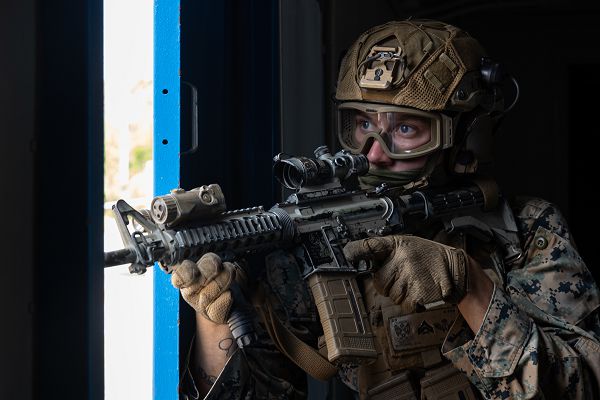
Camp Hansen, Okinawa, Japan. (January 10, 2024): The face of warfare is changing. Rather than the large land operations of World War II, today’s infantry troops find themselves fighting in urban environments where the rules are different. In this photo by Corporal Osmar Gutierrez, Marine Corporal Cole Kitchin, an antitank missile gunner with Battalion Landing Team 1/1, 31st Marine Expeditionary Unit, posts security while participating in urbanized terrain training at Camp Hansen, Okinawa.
Officially called Military Operations in Urban Terrain (MOUT), the course teaches Marines how to plan, organize, and launch successful combat operations in an urban environment. America has learned from bitter experience the challenges of close quarter combat in places like Fallujah, Iraq and is determined to overcome them.
There are many complicating factors in urban warfare, including the presence of civilians and the difficulty of urban terrain. Also, combat in a city negates many advantages of modern armies in armor, heavy artillery, and air support. Ambushes by small groups of insurgents using handheld anti-tank weapons can cause havoc while the technically superior side is hesitant to use artillery or air power for fear of killing civilians. Worse, experience has shown some fanatics deliberately mix with the population using innocent civilians as human shields.
Even worse, it is often difficult to distinguish between civilians and armed militias or local gangs. The enemy often has detailed knowledge of buildings, alleyways, and escape routes and may enjoy the active support of the locals. Destroyed buildings provide excellent posts for snipers and the rubble-filled streets provide multiple places for booby traps.
Finally, commanders must worry about the underground threat posed by tunnels and sewers where insurgents can move undetected about the city, springing ambushes and then disappearing.
To fight on this three-dimensional battlefield, the attacking army needs more manpower to secure a myriad of structures, mountains of rubble, and miles of hidden tunnels. House to house searches means attacking troops are exposed more often than defenders and are the primary source of urban casualties.
Regardless, U.S. military forces are bound by the laws of war and will do everything possible to limit the amount of force used when attacking an area where there are known to be civilians.
Urban warfare will be key to future conflicts and America’s troops want to be ready.


